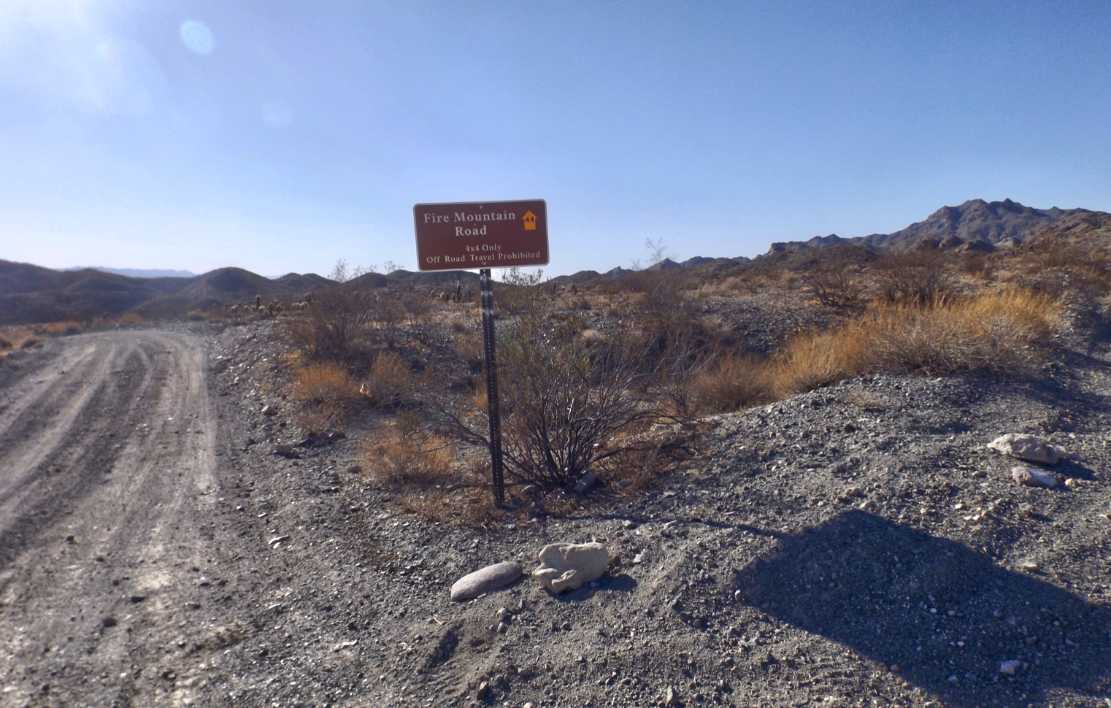
“WHERE WILL WE SPEND THE NIGHT?” It’s a question asked almost daily as we motor across the country checking the boxes. As beginning RVers we make the common mistake of wanting to see everything and sometimes regret not stopping to look at and “smell the roses.”
For us the criteria for the night is a limiting list: Free, safe, level enough for our truck camper, below 7000ft elevation, and away from active human civilization. Beyond those requirements we have preferences: reasonably protected, quiet, fire ring and firewood, room for chairs outside near the RV, interesting landscape, extensive views, pleasing natural odors, instincts positive.
Today the belabored decision is made; wild camping at Fire Mountain Cove on the Colorado River, Lake Mohave, south of Las Vegas, NV. Feeling relief of a GPS coordinated and confirmed target, I remove my chief navigator hat.
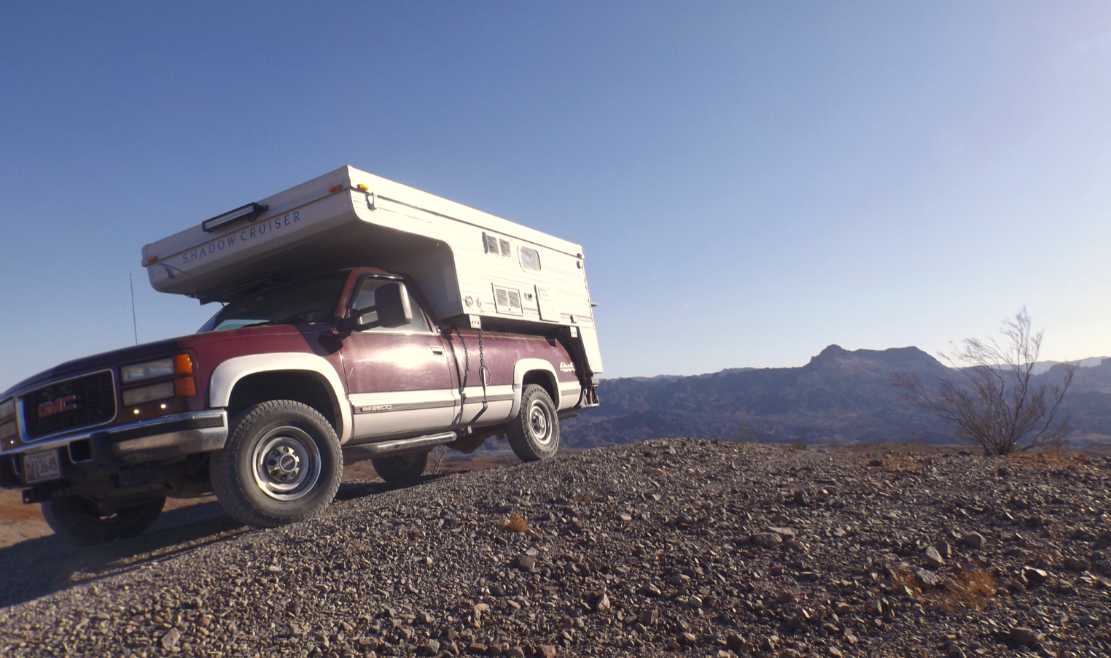
The day is sunny, warm with a strong, consistent, wind; hardly noticeable as the paved road of the last 20 minutes follows a ravine. Turning off the pavement at Copper Cache Trail Head we stop to air down the tires and find my overland hat.
On this graveled and graded roadway we proceed at 20 mph and our concentration priority changes. We can loosen up from the straight jacket of highway speeds and long distant, continuous dodging of others. Additionally pleasing, the truck is gently bumping, lunging and heaving with windows somewhat opened, allowing the fresh varying wind noise. This dynamic also promotes isotonic, buttocks exercises, second only to yoga and walking.
Our focus adapts to multiple ¼ acre desert palettes that come into view as we move across and through dunes or foothills, small valleys and crests. At this speed we register the texture of a cactus, the eroded roots of a small tree likely 50 years old, and a lizard trekking across the hot sand.
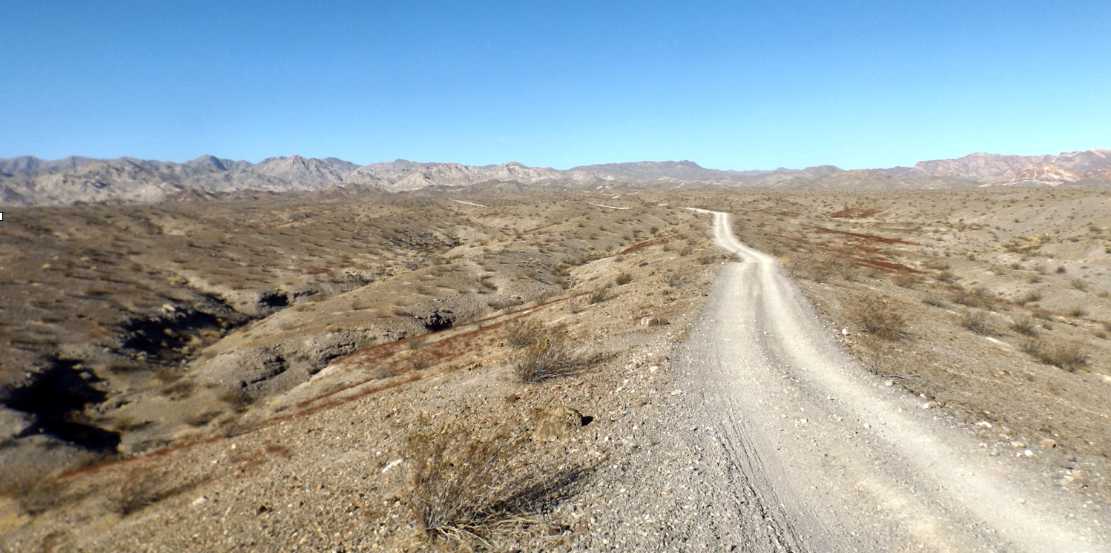
Within a mile, the graveled road changes to trail, sandy and loose. The truck labors and I add pressure to the accelerator. Resting my foot on the transom and rolling it offers better modulation of the torque enabled diesel, until forced to brake. The steering wheel develops its own intentions and drifts from my command. Shifting into 4WD lessens my guiding effort. I try to maintain a speed that will get us to our camp for the night…before night.
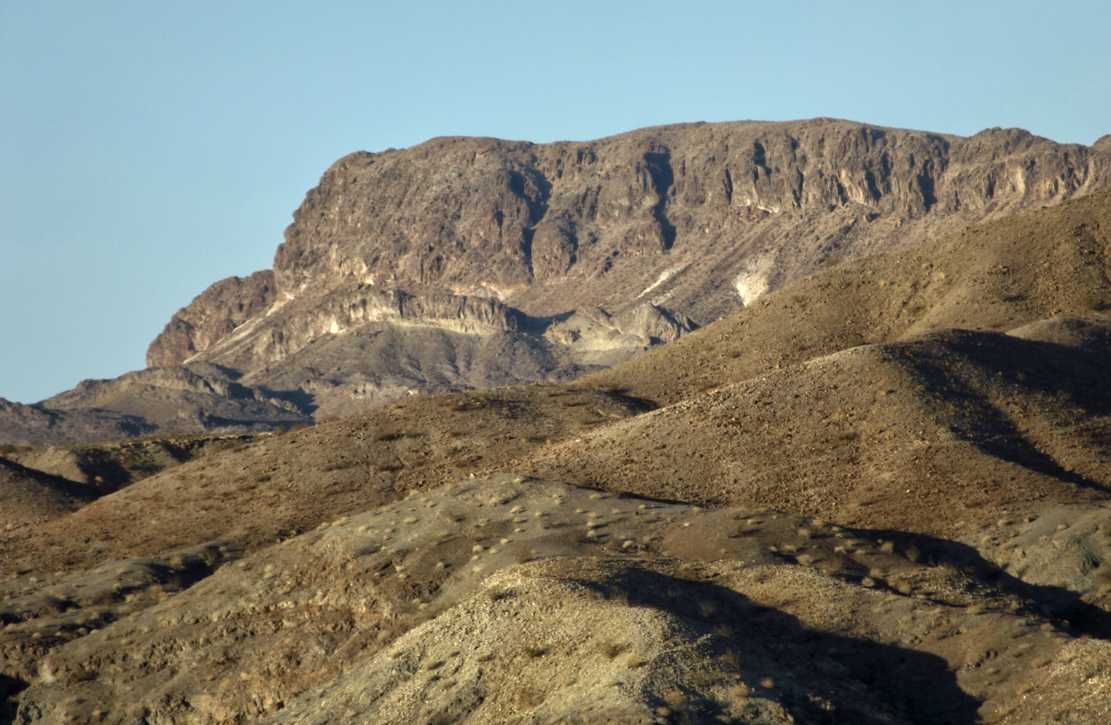
We continue the long elevation decent (~2900 ft) and the road surface changes again. Now it is hard packed ripples. In motorcycle racing we call them whoop-de-doos. In over-landing they are “booby-shakers”. The 27 year old truck’s doors, shaking in their openings, become vocal on the latches, with a rhythm, tell-tale to our speed.
This section of road defined, a 2 track with berms of several feet on both sides. Cresting a hill with a sharp turn at the top (it seems most turns are on the tops of hills) and the road momentarily disappears from our view. We wish the hood were shorter. Gaining sight of the road again we traverse the next tractor trailer sized valley. The course still limited to the truck width and rounding another corner, we see a small 2 door car nuzzled up on a limited siding with no operator. Interesting that a highway vehicle, could make it this far in this terrain.
Another fifty feet and the reason for the parked car is clear. A step-down ledge that requires out-of-cab scrutiny. Finding a line that our fully loaded truck’s stock suspension can handle, we continue on. This element of the trail sets a foundation on which we build anxiety.
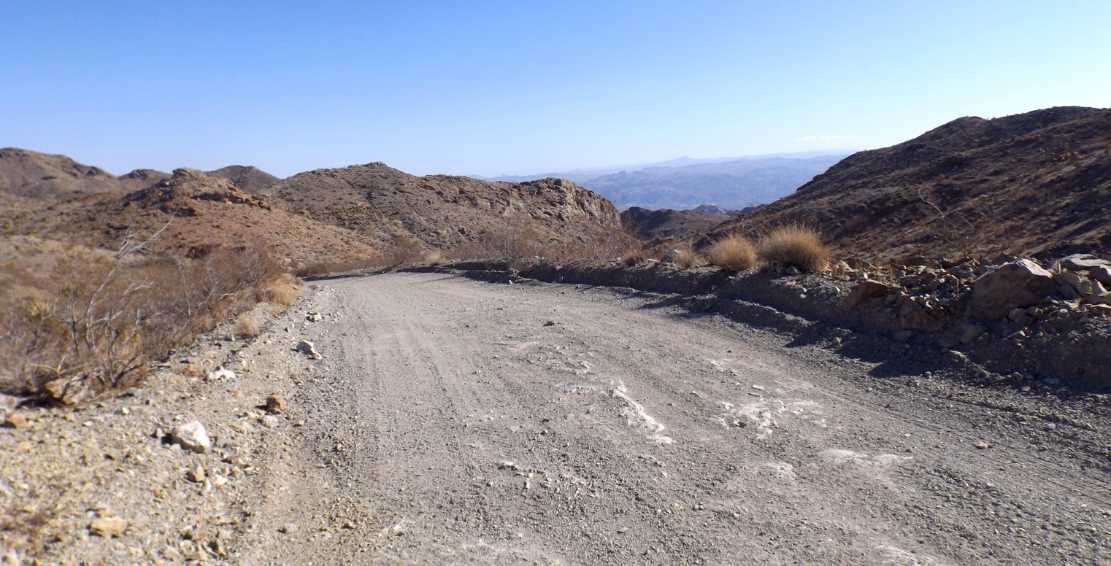
Once again the trail is deep, loose sand for a distance. Continuing a gentle slope downhill, this section is wide, allowing us to choose a line. No matter; the footing is the same in the ruts of others, or riding the ridges. The truck plows, leaving nothing different in the mirror. Fortunately, this is the place we pass the only vehicle for the evening.
Each at 15 mph, our net speed about 30 MPH, enough time to view the 2 occupants of this older, trail warn, slightly lifted 4wd pickup truck. Having traveled for weeks with limited human contact, and devoid of the same in the last 4 hours, we are compelled to inspect the occupants during the moment we pass.
The driver is large featured and bald headed. He lifts two fingers, presenting the familiar, hand on steering wheel wave. He had a straight smile and clear focus on the serious task of navigating his vehicle, staying clear of ours, all the while maintaining speed through the loose sand. The passenger, a thinner man, with hair sticking straight out, as if recently electrocuted, and a terrified look on his face.
Laughter breaks out in our cab. Hormones release providing a needed attitude adjustment. With her naturally thin hair and my ever growing bald spot, together we question: “Will we look like that, when we finish this trail?” The moment passing, we return to our state of concern and intrigue, and continue to wonder what lies ahead.
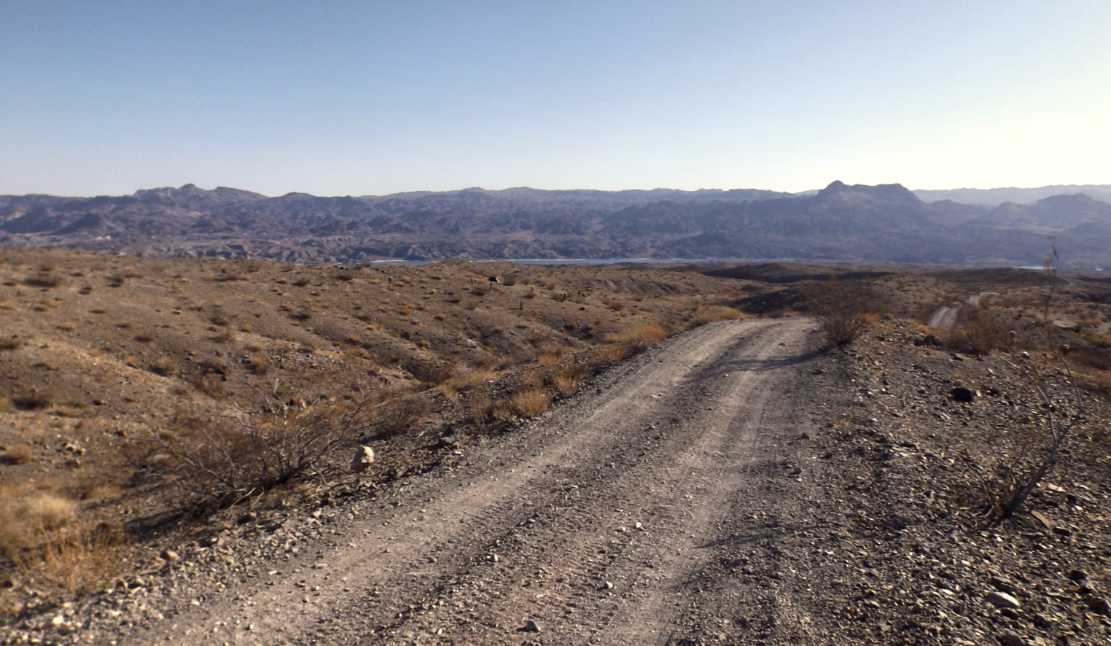
Centering concentration again to 50 feet ahead, road inspection, throttle regulation, braking and swerving, the driving now feels like work. Hope is renewed with a glimpse of the river off in the distance. “See it’s not that far now”! She releases the GPS from its holder, massages the touch screen to zoom out. “Half way there!”…Uggg!
Wrestling on, we begin to get more frequent and longer views of the river, giving hope to an end. The landscape features get larger, more spacious on the generally consistent downward slope. With another section of eroded travel surface and drop off ledge, that warrants close inspection, we exit the cab. The wind blows harder now and we are gently sandblasted. Patience running thinner. We are ready to camp for the night. I also want to get to the river, so we move on.
The two track has been graded by the wind and only has a few holes or large rocks to be avoided. The ecologist in me dictates staying on the road to avoid damaging the delicate tundra surrounding us.
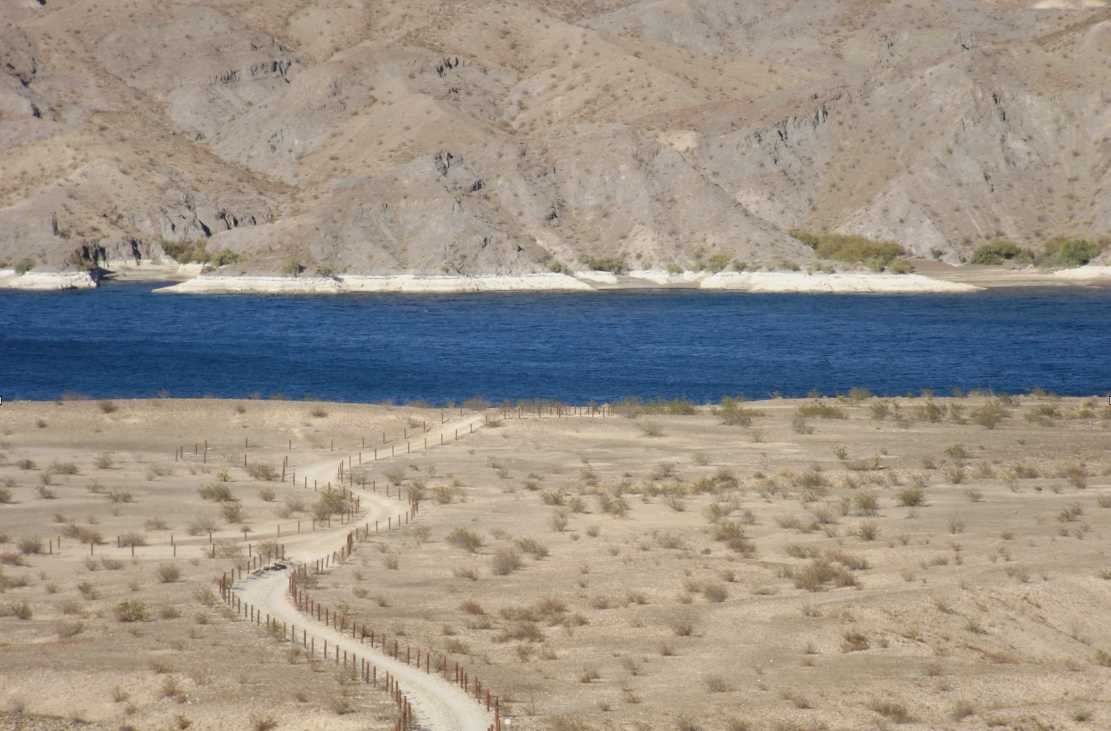
With general overview knowledge from the topographic map I know that we will have to double back to get out of this maze and on our way. Trying to find the upside, self-encouraged to dispel the current misery, I imagine our exit drive. The course will be familiar: Overlanding, uphill, in a soft surface with a diesel engine will require little, to no, brake pedal use. It’s like driving an electric car, release the accelerator pedal and the vehicle nearly stops. Our out-trek will be much less technical. There, “Whew!”, I feel better already!
Climbing onto a ridge, the heebie-jeebies set in. It is barely wide enough for our truck. I conjure horrible images of what going over the side might look like, I draw on “You Tube” video impressions and build an out-of-body mental video of our truck and camper sliding on its side. Quickly, I coach myself out of that stinking thinking, and briefly assuage my anguish.
The wind, now a steady, forceful factor, begins to dominate our hierarchy of worries. We have not tried to pop up our pop-up canvas walled camper in wind like this. I always figured, if caught in an overnight storm, we could put the top down with one sleeping on the single, dinette conversion bed. The other (likely me) on the hard, narrow floor for the night. I never want to have to do that, especially after a couple of hours of technical driving.
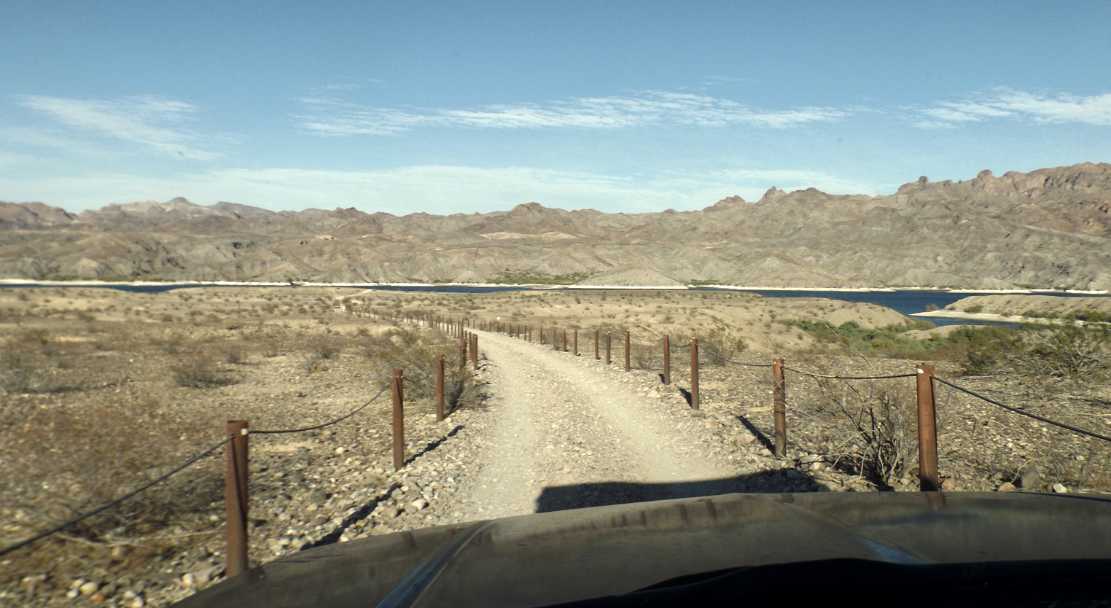
Nearing the river with about ½ mile to go, we enter a steel post and cable assembly that defines the road. It’s the first sign of any Lake Mead National Recreation Area infrastructure or maintenance. We see a large, cabled parking area, on a plateau with a stone fire ring and the familiar brown post with a camping, triangle tent, symbol. This wind makes camping impractical for us so we enter the chute again. As we near the river, we are guided to a turnaround/campsite on a bluff about 20 feet above the water.
Exiting the truck I notice the beautiful, deep blue water, contrasted to the striated, grey, white and black river banks and edge. Waves, certainly with whitecaps, that we can’t see because the wind blows the water away from us, and up river. The wind, strong enough to influence my body but, not requiring a full lean in. This wind caries very fine dust, detected by its unique, incomparable smell, that I can only label “dry dirt”. The shadows are growing longer with the list of what to do next.
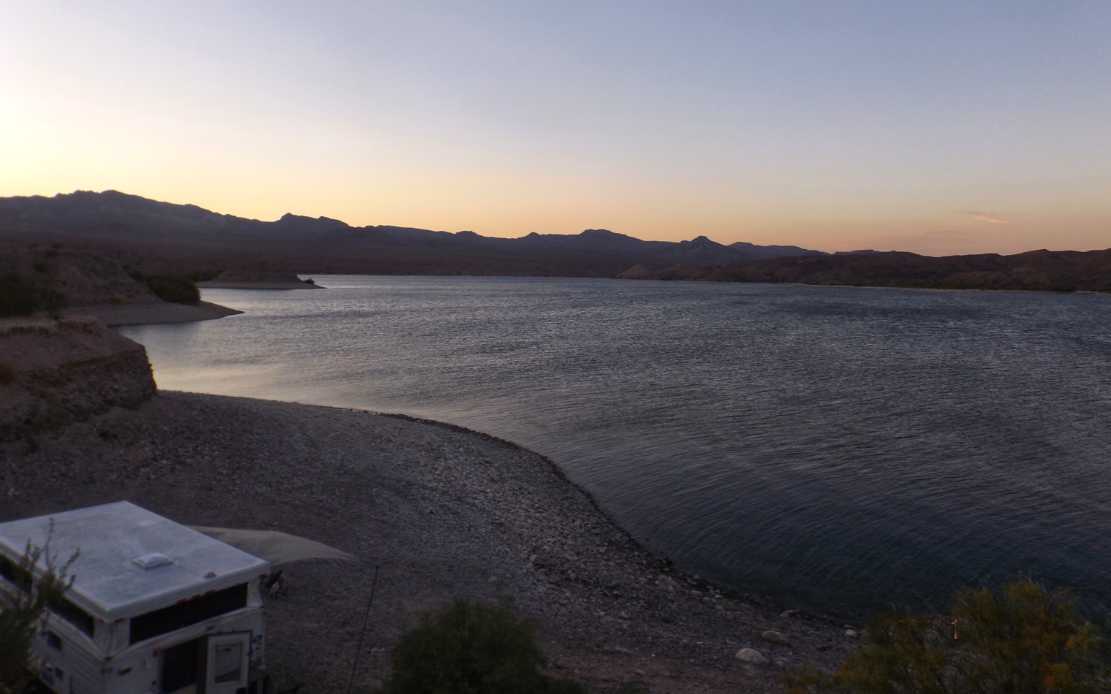
Dreading the thought of having to back track out tonight, to avoid the relentless wind, I consider a quick swim before anything else. Then, she calls out: “Can we get down here?” Walking over I look at a loose, sandy beach area. Inspecting the area, I calculate how to turn around to position our rig beside the bluff that could shelter us. My fear to reverse down the short, steep incline, requires multiple, back and forward moves in loose sand, to face the steep access road and nestle in against the bluff. The army surplus, folding shovel helps create large holes, swallowing the driver’s side wheels. The other side, our home-made, wood block ramps, under the wheels, lifts us just enough to get level.
I duck inside the camper, crank up the roof, change into swimming shorts and fix an adult beverage. I take a deep breath and move outside where I witness the elevated roof about a foot below the level landscape above. This confirms the perfect hideout oasis from the merciless winds. A quick submersion in the cold water and I’m back out in the cooling air. The stress of the day is well released.

Changing into relaxed evening clothes, I don my camp hat and set about the standard chores of the evening to finalize set up. She prepares a sole quieting and very tasty, home cooked meal. We optimistically discuss and anticipate a much easier though unfamiliar trek to tomorrow’s unspecified campsite in Arizona.
We glow on the inside like the unrestricted, rising moon outside.

So well written that I could feel the bumps and see the dirt road! Well done!
I agree, he’s a wonderful story teller that brings his story to life.
I loved it!
The photos complimented your beautiful, detailed thoughts. I loved the, much easier, vicarious trip you took me on.
write more, please.
Excellent writing!
Great job writing this. I felt as if I were in the truck with you. Thanks for taking those of us who don’t have your courage along with you!
Wonderful.
Excellent narrative! Thanks.
????
Wow, Felt like I was there, Very well put together, Well written. Looking forward to more stories like this.
Mark–
This reminded me of the many canoe trips I took with my old friend Barry Campbell, while he was still alive. We went down many western rivers: the Green, the Colorado, the North Platte, the Pecos, the Niobrara. When it came to camping for the night, we sought much the same as you do: a quiet spot, protected, and devoid of “active human civilization,” as you put it. Indeed, as we paddled along, Barry, in the bow, often alerted me to what we worked so hard to avoid. “MAN,” he would whisper back over his shoulder, if we came upon a structure, or God forbid, an actual person. Yes, we loved being out there in the wilds, alone and peaceful.
I enjoyed the short story. I felt like I was making the trip with you.
Now your mission is to take us all on another trip. ?
Great piece, controlling truck in those conditions kept me in suspense. as to your getting out! M.Davis
Great story telling – fun to read.
Very nice pictures and well explained. Thought I was in the truck with you and my buttocks tightened.
At this: With her naturally thin hair and my ever growing bald spot, together we question: “Will we look like that, when we finish this trail?” I literally laughed loudly!! Could see myself doing and saying the same thing. Great story while wondering “ could my rig make it there?” Lol